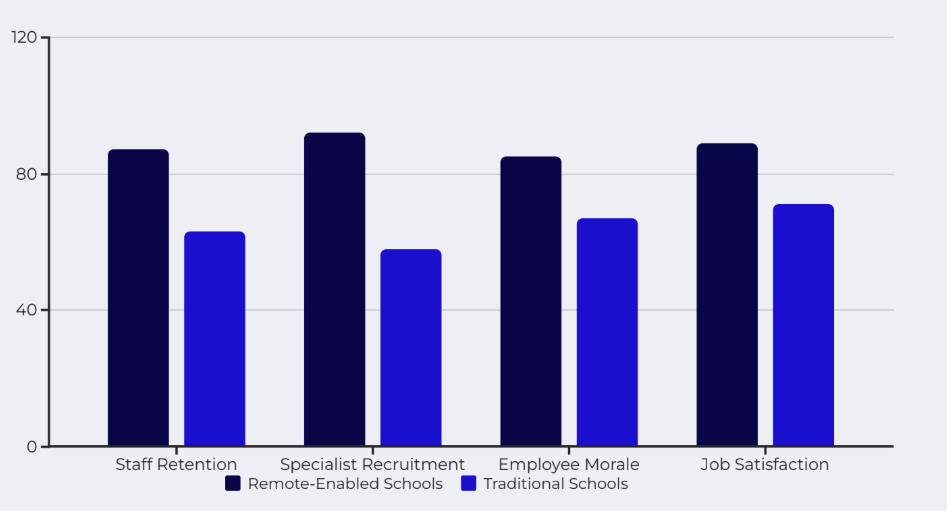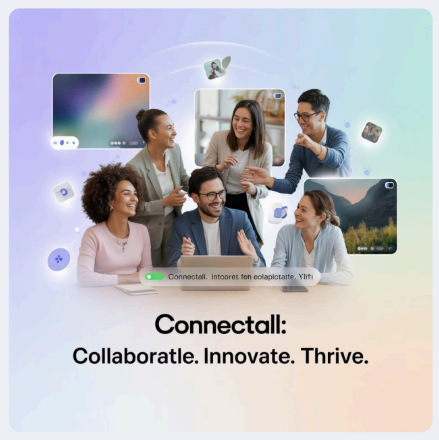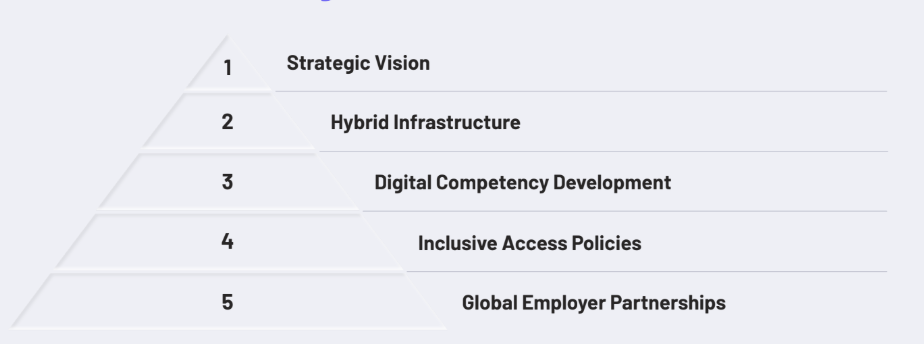The Work-from-Home Revolution: A New Era for Placement Schools
The landscape of education and career development has undergone a profound transformation in recent years, with work-from-home (WFH) opportunities revolutionizing how placement schools connect students with meaningful professional experiences. This paradigm shift, accelerated by global circumstances, has created unprecedented advantages for educational institutions and their students. With two-thirds of U.S. remote workers expressing a desire to continue working from home post-pandemic, and placement schools reporting a surge in remote opportunities across the education sector, we are witnessing the dawn of a new era in career preparation and professional development. Virtual placements are reshaping access to quality opportunities, particularly for non-urban students, while opening doors to diverse experiences that were previously geographically restricted.
Remote Work, Real Results: Productivity and Performance
Average productivity improvement reported by placement schools with remote work programs
Decrease in staff absence rates following remote work implementation
Percentage of remote participants reporting high engagement levels outside traditional settings
Contrary to initial skepticism, remote work arrangements have demonstrated impressive results across placement school environments. Educational institutions consistently report improved performance metrics and heightened productivity when implementing flexible work arrangements. The data tells a compelling story: staff members working remotely exhibit significantly lower absenteeism rates compared to their on-site counterparts, resulting in more consistent service delivery and student support.
Perhaps most surprising to traditional education administrators has been the evidence of sustained4and often increased4engagement levels among remote workers. Without the distractions of a conventional workplace setting, many professionals report deeper focus on core responsibilities and greater satisfaction with their accomplishments. This heightened engagement translates directly to better outcomes for students and placement success rates.
These performance improvements aren’t merely anecdotal. Quantitative assessments across multiple placement school programs demonstrate that remote arrangements frequently lead to more efficient workflow management, better documentation, and more attentive student interaction. The removal of physical workplace stressors, including commuting fatigue and office politics, allows education professionals to direct more energy toward their primary mission: connecting students with meaningful career opportunities.
Flexible Careers: Work-from-Home as an Empowerment Tool
Transformative Benefits of Flexibility
The elimination of rigid scheduling and commuting requirements has emerged as a powerful empowerment tool for both staff and students in placement school environments. With the average American commuter spending nearly an hour daily traveling to and from work, remote arrangements effectively gift participants additional time for professional development, family obligations, or personal well-being.
This newfound flexibility allows staff members to adapt their work schedules around life commitments rather than the reverse, resulting in measurably higher morale and job satisfaction. For students engaged in remote placements, this adaptability proves equally valuable, enabling them to balance academic responsibilities with professional opportunities that might otherwise remain inaccessible.
Forward-thinking placement schools have recognized this flexibility as a competitive advantage in talent acquisition and retention. By offering remote work options, these institutions can attract top-tier professionals who might otherwise gravitate toward private sector opportunities. The ability to work from anywhere becomes particularly appealing to specialists with niche expertise, allowing placement schools to access talent pools previously limited by geographic constraints.

The psychological benefits of this flexibility further enhance program outcomes. When individuals experience greater autonomy over their work environment and schedule, they typically report higher levels of job satisfaction and organizational commitment. This translates directly to more enthusiastic engagement with students and employer partners, creating a positive feedback loop that elevates the entire placement ecosystem.
Expanding Access: No Geographic or Economic Barriers
One of the most transformative aspects of the work-from-home revolution is its power to democratize access to quality placement opportunities. Traditionally, students from rural and regional areas faced significant barriers to accessing premier employers, often requiring costly relocation or prohibitive commutes. Remote placements have effectively eliminated these geographic constraints, enabling students from any location to engage with top-tier organizations without leaving their communities.
The economic implications of this shift are equally profound. By removing the need for relocation, temporary housing, and daily transportation expenses, remote placements have made internship and job placement experiences financially viable for a much broader segment of the student population. This reduction in economic barriers has enabled placement schools to support more equitable participation across socioeconomic backgrounds.
Simultaneously, educational institutions themselves have experienced a dramatic expansion of their potential applicant pools. No longer constrained by physical proximity, placement schools can attract talented individuals from diverse geographic and cultural backgrounds, enriching their programs with varied perspectives and experiences. This expanded reach ultimately benefits all stakeholders, creating more dynamic learning environments and better preparing students for increasingly global professional landscapes.
Global Reach
Students can access opportunities from companies worldwide without relocation constraints
Cost Reduction
Elimination of travel and housing expenses makes internships financially accessible
Diverse Talent
Schools' applicant pools expand to include more varied backgrounds and perspectives
Rural Inclusion
Students from remote areas gain access to opportunities previously limited to urban centers
Building the 21st-Century Skillset Remotely
Beyond merely connecting students with employment opportunities, remote placements actively cultivate the precise competencies employers seek in the evolving job market. The skills developed through virtual work experiences align remarkably well with the demands of the 21st-century workplace, creating a natural training ground for future career success.
Employers increasingly emphasize the importance of digital literacy, self-direction, and adaptive problem-solving in their hiring criteria. Remote placements naturally foster these attributes, as students navigate digital collaboration platforms, manage their own schedules, and troubleshoot technological challenges independently. The ability to remain productive without direct supervision has become a distinguishing qualification that remote placement experiences effectively demonstrate.
Perhaps most significantly, these virtual work experiences provide tangible evidence of adaptability4a quality consistently ranked among the most desirable by hiring managers. Students who successfully navigate remote placements can point to concrete examples of their flexibility and resilience during future job interviews, giving them a competitive edge in increasingly crowded applicant pools.
Digital Literacy
Remote placements necessitate proficiency with collaboration tools, digital communication platforms, and specialized software applications that are increasingly essential in modern workplaces.
Time Management
Virtual work environments develop stronger self- discipline and organizational skills as students learn to structure their work effectively without direct supervision.
Creative Problem-Solving
Remote settings frequently present unique challenges that foster innovative thinking and resourcefulness in finding solutions outside traditional frameworks.
Virtual Communication
Students develop precision in written communication and confidence in video presentations4skills increasingly valued in the digital workplace.
Attracting and Retaining Great Talent in Education

In the competitive landscape of educational talent acquisition, remote work options have emerged as a decisive strategic advantage. Placement schools that embrace flexible work arrangements consistently outperform their traditional counterparts in recruitment metrics, particularly for specialized roles that require unique expertise. By offering remote positions, these institutions effectively expand their candidate pools beyond geographic limitations, accessing talent that might otherwise remain beyond reach.
This recruitment advantage proves especially valuable for specialized services like career counseling, internship coordination, and therapeutic support. Professionals with these niche skill sets often command premium compensation in the private sector, but many are willing to accept educational roles when remote flexibility is part of the package. The work-from-home option effectively serves as a non-monetary benefit that enhances the overall attractiveness of positions within placement schools.
Beyond initial recruitment, remote work policies demonstrate significant impact on staff retention and organizational commitment. Schools that implement thoughtful remote work programs report markedly higher employee morale, reduced turnover, and stronger institutional loyalty. This stability translates directly to program quality, as consistent staffing enables the development of deeper relationships with employer partners and more personalized student support. By embracing remote options, placement schools position themselves advantageously in the ongoing competition for educational talent.
Diversity & Inclusion: Leveling the Playing Field
Broadening Representation
The transition to remote placement opportunities has significantly enhanced diversity and inclusion efforts across educational institutions. By eliminating geographic constraints, virtual placements naturally widen recruitment reach, enabling schools to connect with students and staff from varied socioeconomic and cultural backgrounds. This expanded accessibility creates more representative learning environments that better reflect the diverse societies students will ultimately serve.
For individuals with disabilities, remote options have proven particularly transformative. The Americans with Disabilities Act (ADA) accommodations that might require complex physical modifications in traditional settings often become simpler to implement in virtual environments. Assistive technologies, flexible scheduling, and customized workspace arrangements allow for more seamless integration of diverse needs, removing barriers that previously limited full participation.
The benefits of this increased diversity extend beyond mere representation. When placement programs include participants from varied backgrounds, they naturally cultivate more robust learning communities. Students exposed to diverse perspectives develop stronger critical thinking skills and cultural competencies that prove invaluable in increasingly global workplaces. Similarly, staff members from different backgrounds bring varied approaches to problem-solving and student support, enhancing program effectiveness.

For many placement schools, remote options have become central to their diversity, equity, and inclusion (DEI) strategies. By consciously leveraging virtual platforms to reach underrepresented communities, these institutions are actively working to correct historical imbalances in educational access and career opportunity. The resulting diversity enriches the educational experience for all participants while preparing students for success in increasingly heterogeneous professional environments.
Remote Work, Real Results: Productivity and Performance
Rural STEM Access Initiative
A consortium of rural high schools partnered with a placement program offering remote internships with leading technology firms. Students from communities without local tech employers gained hands-on experience with cutting-edge projects, resulting in 78% of participants securing further education or employment in STEM fields4a 45% increase over pre-program rates.
Rural STEM Access Initiative
A school district struggling to staff specialized therapy positions implemented a remote service delivery model, connecting students with therapists across multiple regions. The program eliminated a two-year waiting list for services while reducing per- student costs by 34%, demonstrating both improved access and financial sustainability.
Global Finance Mentorship
An urban community college developed a virtual mentorship program connecting first- generation college students with finance professionals worldwide. The remote format enabled participation from Wall Street executives, international banking leaders, and fintech entrepreneurs who would have been inaccessible through traditional means, resulting in a 150% increase in financial sector placements.
These success stories represent just a fraction of the innovative approaches emerging across placement schools nationwide. Institutions that have embraced remote options consistently report improved outcomes across key metrics, including placement rates, student satisfaction, and long-term career progression. The flexibility of virtual formats has proven particularly valuable for specialized fields and underserved populations, creating pathways to opportunity that simply didn’t exist in traditional models.
Perhaps most compelling are the retention statistics from schools that have implemented comprehensive remote programs. These institutions report significantly higher completion rates, with students more likely to persist through challenges when they can engage from comfortable, familiar environments. This increased persistence translates directly to better placement outcomes and stronger long-term career trajectories, creating a powerful argument for continued investment in virtual opportunities.
Overcoming Challenges: Solutions that Work
Social Isolation
Structured Connection Points
Scheduled virtual coffee breaks, mentorship pairings, and cohort- based activities to maintain community
Communication Barriers
Multi-Channel Communication
Clear guidelines for which platforms to use for different purposes (instant messaging, email, video calls)
Technology Disparities
Equipment Lending Libraries
Provision of necessary hardware
and connectivity solutions to
ensure equitable access
Work/Life Boundaries
Clear Expectations Framework
Documented policies regarding response times, meeting scheduling, and off-hours communication
Performance Evaluation
Outcome-Based Assessment
Shift from time-based to deliverable-based evaluation metrics with regular feedback cycles
While the advantages of remote placements are substantial, successful implementation requires thoughtful strategies to address inherent challenges. Progressive placement schools have developed effective approaches to overcome potential obstacles, ensuring that virtual programs deliver comparable4or superior4results to traditional models.
Addressing the risk of isolation has emerged as a primary focus, with successful programs implementing structured routines that foster connection and community. Regular check-ins, virtual social events, and intentional team-building activities help maintain the interpersonal relationships that underpin effective educational environments. Similarly, clear communication protocols mitigate the risk of misunderstandings or information gaps that can occur without in-person interaction.
Technology support represents another critical success factor. Leading placement schools have developed comprehensive digital literacy training programs for both staff and students, ensuring that all participants possess the technical competencies required for effective remote engagement. These institutions typically maintain dedicated support teams to address technical challenges promptly, minimizing disruption to the learning experience.
Perhaps most importantly, successful remote programs establish clear guidelines and expectations that provide structure without sacrificing flexibility. Well-defined deliverables, communication protocols, and performance metrics create accountability while allowing participants to manage their work in ways that accommodate individual circumstances. This balance of structure and autonomy has proven essential to maintaining motivation and ensuring continuity of outcomes in virtual environments.
The Future-Ready Placement School: Maximizing the WFH Advantage

As we look toward the future, it’s clear that hybrid and remote models are becoming standard features of competitive placement schools rather than temporary accommodations. The institutions that will thrive in this evolving landscape are those that strategically embrace the work-from-home advantage as a cornerstone of their educational and placement philosophy. These forward-thinking schools are actively investing in the technology, training, and organizational structures needed to support seamless virtual experiences while maintaining rigorous educational standards.
This proactive approach recognizes a fundamental truth: today’s students are preparing for a workforce that will be increasingly digital, distributed, and flexible. By incorporating remote experiences into their placement programs, schools effectively position their graduates for success in this emerging reality. Students who have navigated virtual professional environments during their education enter the workforce with valuable competencies that distinguish them from peers limited to traditional experiences.
The most innovative placement schools are going beyond merely offering remote options4they’re fundamentally reimagining how career preparation can unfold in virtual contexts. These institutions are developing sophisticated digital platforms that facilitate meaningful connections between students and employers, creating immersive learning environments that transcend physical limitations. They’re leveraging data analytics to personalize placement pathways, matching students with opportunities that align precisely with their skills and aspirations regardless of geographic constraints.
As the work-from-home revolution continues to reshape education and employment, placement schools that embrace this transformation position themselves as leaders in preparing students for the dynamic careers of tomorrow. The WFH advantage has evolved from a temporary necessity to an enduring cornerstone of modern educational strategy4one that expands access, enhances outcomes, and empowers students to thrive in an increasingly digital professional landscape.
